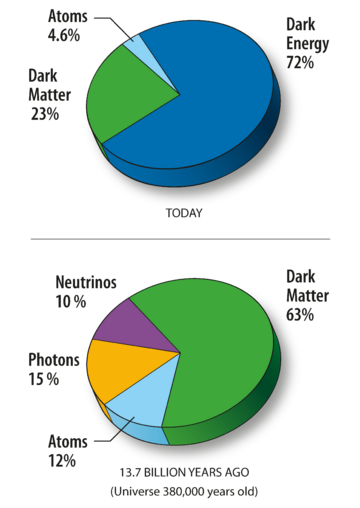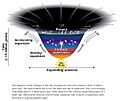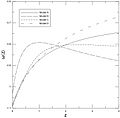Dark energy facts for kids
In physical cosmology and astronomy, dark energy is a mysterious type of energy that affects the universe on its largest scales. It's like an invisible force that pushes the universe to expand faster and faster. It also slows down how quickly large structures, like groups of galaxies, form.
Scientists believe dark energy makes up about 68% of everything in the observable universe. Dark matter makes up about 27%, and regular matter (like stars, planets, and us) is only about 5%. Other things, like neutrinos and photons (light particles), are very tiny parts of the universe's total energy. Dark energy isn't very dense, meaning there's not much of it in any one spot. However, it's spread out everywhere, so it ends up being the most common thing in the universe.
The first hint that dark energy existed came from studying exploding stars called supernovae. Scientists looked at a special type called Type Ia supernovae. These explosions always have the same brightness, so they act like "standard candles" that help astronomers measure distances in space. By comparing how far away these supernovae were to how fast they were moving away from us (measured by something called redshift), scientists discovered that the universe's expansion is actually speeding up. Before this, most scientists thought gravity would slow the universe's expansion over time. Since this discovery, many other observations have also supported the idea of dark energy.
What exactly dark energy is remains a big puzzle. Scientists have many ideas. One main idea is that it's a cosmological constant, which means it's a constant energy that fills all of space. Another idea is that it's made of scalar fields, which are dynamic quantities whose energy can change over time and space. These are sometimes called quintessence. Other ideas include dark energy interacting with other things, or that our observations might be misleading us.
| Physical cosmology | ||||||||||||||
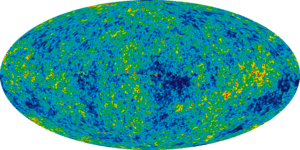 |
||||||||||||||
| Universe · Big Bang Age of the universe Timeline of the Big Bang Ultimate fate of the universe
|
||||||||||||||
Contents
How Dark Energy Was Discovered
Einstein's Early Idea
Long ago, Albert Einstein thought the universe was static, meaning it wasn't expanding or shrinking. To make his equations for gravity work for a static universe, he added something called the "cosmological constant" (symbol: Λ). He imagined it as a kind of energy in empty space that would push back against gravity.
However, Einstein later realized his static universe idea was wrong. Observations by Edwin Hubble in 1929 showed that the universe is actually expanding. Einstein reportedly called his idea of a static universe his "greatest blunder." But it turns out his cosmological constant, or something like it, might be real after all!
The Idea of Inflation
In the 1980s, scientists like Alan Guth and Alexei Starobinsky suggested that a force similar to dark energy caused a super-fast expansion of the universe right after the Big Bang. This idea is called cosmic inflation. It explains how the universe became so big and smooth in a tiny fraction of a second. This early expansion was much more powerful than the dark energy we see today.
Even after inflation became a popular idea, scientists didn't think the cosmological constant was important for the current universe. But then, in 1998, something surprising happened.
The Big Discovery: Accelerating Expansion
In 1998, two teams of scientists, the High-Z Supernova Search Team and the Supernova Cosmology Project, were studying distant Type Ia supernovae. They expected to see the universe's expansion slowing down due to gravity. Instead, they found it was speeding up! This was a huge shock.
This discovery meant there had to be some unknown force pushing the universe apart. This force was named "dark energy" by Michael S. Turner in 1998. The scientists who led this discovery, Saul Perlmutter, Brian P. Schmidt, and Adam G. Riess, won the Nobel Prize in Physics in 2011.
Since then, many other observations have confirmed this. Experiments studying the cosmic microwave background (the leftover heat from the Big Bang) and the way galaxies are spread out in space have all supported the idea of dark energy.
What Dark Energy Is Like
Dark energy is still very mysterious. We think it's spread out evenly across space and isn't very dense. It doesn't seem to interact with anything except through gravity. Because it's so spread out and not dense, it's almost impossible to detect in labs on Earth.
Scientists believe dark energy has a strong "negative pressure." This means it acts like a force that pushes things apart, rather than pulling them together like normal gravity. This negative pressure is what makes the universe expand faster.
How Dark Energy Changes Over Time
Scientists are trying to figure out if dark energy's strength changes over time. The simplest idea is that it's a cosmological constant, meaning its energy density never changes. This is part of the "Lambda-CDM model," which is the most accepted model of the universe right now.
However, some recent observations from the Dark Energy Spectroscopic Instrument (DESI) collaboration, announced in March 2025, hint that the density of dark energy might be slowly decreasing. This is still being studied, and more data is needed to be sure.
Proof That Dark Energy Exists
The evidence for dark energy comes from three main sources:
- Measuring Distances: By looking at how far away objects are and how fast they are moving away from us (their redshift), scientists see that the universe has expanded more in its recent history than it did earlier. This points to an accelerating expansion.
- Flat Universe: Measurements of the cosmic microwave background show that the universe is "flat," meaning it has no overall curve. For the universe to be flat, it needs a certain amount of total energy. But when scientists add up all the normal matter and dark matter, it's not enough. Dark energy makes up the missing amount needed for a flat universe.
- Large-Scale Patterns: Scientists study how galaxies are grouped together in the universe. These patterns also suggest that there's a lot of something invisible, like dark energy, affecting how structures form.
Supernovae as Cosmic Markers
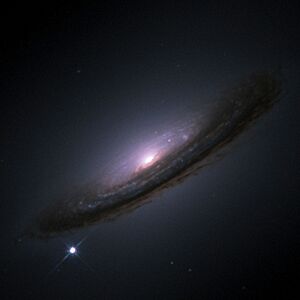
As mentioned, Type Ia supernovae are like cosmic "standard candles." They explode with a very consistent brightness. This allows astronomers to figure out how far away they are. By comparing their distance to their redshift (how much their light is stretched because they're moving away), scientists can map out the universe's expansion history. The fact that distant supernovae appear dimmer than expected means they are farther away than they would be if the universe's expansion was slowing down. This is strong evidence for acceleration.
Cosmic Microwave Background
The cosmic microwave background (CMB) is the oldest light we can see, from when the universe was very young. Tiny temperature differences in the CMB tell us about the early universe. These measurements show that the universe is very close to being flat. For a flat universe, the total amount of matter and energy must equal a specific "critical density."
However, when scientists measure all the normal matter and dark matter in the universe, it only adds up to about 30% of this critical density. This means there must be something else making up the other 70%. That "something else" is dark energy. More recent and precise measurements from the Planck spacecraft in 2013 estimated the universe is 68.3% dark energy, 26.8% dark matter, and 4.9% ordinary matter.
Ideas About Dark Energy
Since we don't know what dark energy is, scientists are exploring many ideas.
The Cosmological Constant
The simplest idea is that dark energy is the cosmological constant (Λ), which Einstein first thought of. This means it's a basic, unchanging energy that belongs to space itself. If space expands, more space appears, and with it, more of this constant energy. This would naturally cause the universe to speed up its expansion.
The biggest problem with this idea is that our best theories of tiny particles (quantum field theories) predict that this "vacuum energy" should be incredibly huge, far, far bigger than what we observe. This is one of the biggest unsolved puzzles in physics.
Quintessence
Another idea is called quintessence. This suggests that dark energy isn't constant but comes from a changing scalar field. Think of it like a field that fills space, and its energy can change over time and in different places. If this field is very light, it wouldn't clump together like matter, which fits with what we know about dark energy.
Quintessence models often predict that the universe's acceleration might be slightly different from what a cosmological constant would cause. Scientists are constantly looking for clues to tell these ideas apart.
Interacting Dark Energy
Some theories suggest that dark energy might not be alone. It could interact with dark matter or even with regular matter. For example, dark matter might slowly decay into dark energy. Or, dark energy and dark matter could be two sides of the same unknown substance. These ideas are still being explored.
Variable Dark Energy Models
Scientists are also looking at models where the density of dark energy changes over the universe's history. Recent data from the Dark Energy Spectroscopic Instrument (DESI) suggests that dark energy might have been about 10% stronger 4.5 billion years ago than it is today. This is exciting, but more data is needed to confirm if dark energy is truly changing.
Other Ideas Instead of Dark Energy
Some scientists wonder if dark energy is even real, or if there's another explanation for the accelerating universe.
Modified Gravity
One idea is that our understanding of gravity (Einstein's general relativity) might be incomplete. Perhaps if we change the laws of gravity, we wouldn't need dark energy to explain the observations. However, many of these "modified gravity" theories have been ruled out by recent observations, like the detection of gravitational waves. Most astrophysicists still believe dark energy is the best explanation.
Observational Effects
Another idea is that the accelerating expansion is just an illusion. Maybe we live in an emptier-than-average part of the universe, and that makes it look like everything is speeding up. Or perhaps there's something wrong with how we measure things. However, most cosmologists don't find these ideas very convincing because the evidence for dark energy comes from so many different sources.
Black Holes and Shockwaves
Some newer, more speculative ideas include:
- Black Holes: A theory from 2023 suggests that if black holes gain mass as the universe expands, their energy density could stay constant, mimicking dark energy. This is called "cosmological coupling."
- Shockwave Cosmology: This idea suggests the Big Bang was an explosion inside a black hole, and our part of the universe might have a lower density, causing the observed acceleration. These ideas are still very new and need a lot more research to be accepted.
What Dark Energy Means for the Universe's Future
Scientists believe the universe started speeding up its expansion about 5 billion years ago. Before that, gravity was slowing it down. But as the universe expanded, dark matter became more spread out, while dark energy (if it's a cosmological constant) stayed the same density. Eventually, dark energy became the dominant force.
The future of the universe depends on what dark energy truly is:
- If Dark Energy is Constant: If dark energy stays constant, the universe will keep expanding faster and faster forever. Eventually, galaxies outside our local group will move away so quickly that their light will never reach us. The universe will become a cold, empty place, with only our local group of galaxies remaining visible. This is often called the "heat death."
- Other Ideas:
* Some models, like "phantom dark energy," suggest dark energy could get stronger over time. This could lead to a "Big Rip," where dark energy tears apart everything, even atoms themselves. * Other ideas suggest dark energy might weaken or even become attractive. This could lead to a "Big Crunch," where the universe eventually stops expanding and collapses back on itself. * There's even a "cyclic model" where the universe goes through endless cycles of Big Bangs and Big Crunches.
Right now, the "heat death" scenario (with a constant dark energy) is the most likely future based on our current observations. But the exact nature of dark energy is still a huge mystery, and solving it will tell us a lot about the ultimate fate of our universe!
Images for kids
See also
 In Spanish: Energía oscura para niños
In Spanish: Energía oscura para niños


